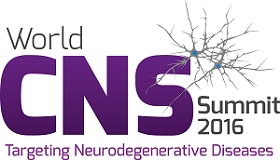Day One
Tuesday 23rd February, 2016
Day Two
Wednesday 24th February, 2015
08:50 Chair’s Opening Remarks
Advances in Imaging and Diagnostics – Developing Fit for Purpose Biomarkers
09:00 Utilizing Neuroimaging to Develop Strategies for Multiple Sclerosis Programs • Identification of neuroinflammatory
Synopsis
• Identification of neuroinflammatory markers in Multiple Sclerosis
• How to best use inflammatory imaging to support early clinical programs
• Defining methodologies to more accurately observe the process of remyelination
09:30 Improving Diagnostic Capabilities to Earlier Identify Patients Before the Onset of Cognitive Symptoms
Synopsis
• Applying lipidomics and blood based biomarkers as diagnostic tools in Alzheimer’s Disease
• Increasing accuracy in the predictability of Alzheimer’s Disease progression in preclinical patients
• Implementing diagnostic strategies to help prove clinical disease modification
10:00 Incorporating Neuroimaging in Advancing Biomarker Monitoring: Bases & Challenges
Synopsis
• Understanding the known neurophysiological and metabolic bases of currently employed in vivo functional imaging techniques (fMRI and PET)
• What can and cannot be known about biological processes from neuroimaging data
• How can imaging techniques be most effectively used as biomarkers for cognitive and biological function and decline?
10:30 Perspective on Companion Diagnostics in Neurodegeneration
10:45 Morning Refreshments & Speed Networking
11:45 Impacting Decisions with Imaging in Neuroscience Drug Discovery & Early Development
Synopsis
• Challenges to the pharmaceutical industry; the odds are against us
• Improving the value of decision making with imaging (MRI, PET, and SPECT)
• Preclinical and clinical examples of selecting the right target, dose, and “patient” using imaging
12:15 Molecular Imaging as a Tool for Risk Reduction in CNS Drug Development
Synopsis
- Accelerated development of PET biomarkers for CNS disease
- Measurement of Drug-Target Engagement
- Pharmacodynamic markers for Neurodegenerative diseases
Cracking Neurodegeneration – The Power of Genetics to Transform Discovery & Development in CNS
12:25 Harnessing the Power of Whole Genome Sequencing to Advance Our Understanding of Neurodegenerative Diseases
Synopsis
• Analyzing the Alzheimer’s Genome ProjectTM: a case study in utilizing genome wide sequencing in neurodegenerative diseases
• Insight and results from the analysis of ~2,300 genomes using novel bioinformatics and statistical tools to identify “functional” variants influencing risk for Alzheimer’s disease
• Using genetics to accelerate the personalized medicine paradigm in the diagnosis and therapeutic interventions in the field of neurodegeneration
12:55 Networking Lunch
13:55 The Genetics Behind the Functions & Dysfunctions of the Brain
Synopsis
• Utilizing population data and genomics for the analysis and prediction of disease
• Identification of genetic risk alleles in neurodegenerative disease
• Improving our understanding of how risk alleles contribute to disease pathogenesis and can be targeted with therapeutics
13:55 Human Genetics: Brain Function and Dysfunction
14:25 Scoring a Therapeutic Bulls-Eye with Genetic Medicine Targeted to the CNS
Synopsis
• Bypassing the blood-brain barrier: advantages of targeted delivery to the CNS
• Optimizing delivery to fit the therapy and the disease in question
• Developing viral vectors for treating neurodegenerative disease
Of Mice & Men – Can We Ever Really Model Neurodegeneration in the Lab?
14:55 Characterization, Comparison, & Cross-Validation of Alpha- Synuclein Preclinical Models of Parkinson’s Disease
Synopsis
• Standardized phenotypic characterization of rodent models of Parkinson’s Disease
• Independent replication of preclinical models using contract research laboratories
• Adding value and utility of preclinical models for researchers seeking to test potential therapeutics targeting alpha-synuclein
15:15 Afternoon Refreshments & Networking
15:45 Making Preclinical Models More Translatable to Accelerate New Targets into Clinical Trials
Synopsis
• Improving the predictive therapeutic accuracy in pre-clinical models with the influence of imaging and biomarkers
• How to best make pharmacokinetic/pharmacodynamic modelling more translatable
• Promoting momentum and progression from the model to the clinic by maximising translatability
16:05 Translatable Alternatives to the Animal Model: The Future of Modelling Systems Routed in Stem Cell Technology
Synopsis
• Utilizing stem cell based models for the generation of genetic models of neurodegenerative disease with a view to personalised medicine
• How to best scale up stem cell models of disease to allow for intelligent high throughput screening and drug validation
• Revolutionizing the analysis of genotype-phenotype interactions in neurodegenerative disorders by employing neuronal stem cell systems
16:25 New Ways to Stimulate Drug Discovery in Neuroscience Using Human Derived Cells for Modeling Neurodegenerative Diseases
Synopsis
• Strategies for transnational neuroscience
• From the identification of novel targets based on human genetic to drug discovery projects: Development of relevant assays using iPSC-derived human neurons
• Focusing on neurodegenerative proteinopathies
• Impacts of iPSC-derived neurons models to support discovery of disease-specific therapeutic targets
16:45 Panel Discussion: Debating the Relevance of the Animal Model in the Field of Neurodegeneration
Synopsis
• In the face of evolving in silico and human tissue models, do animal models still have a place in CNS research?
• How does the drug discovery landscape look without the use of pre-clinical animal models?
• Fully harnessing the potential of human data to revolutionize pre-clinical drug development
• Understanding the limits of our models to rationalize therapeutic expectations and ultimately improve drug progression through to the clinic
• Building upon the failure of past models to inspire their evolution into therapeutically relevant systems



